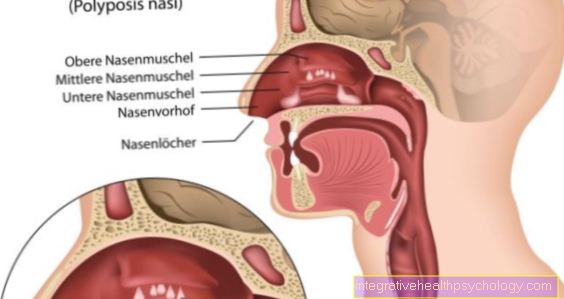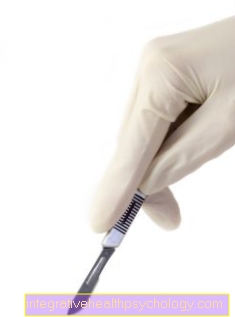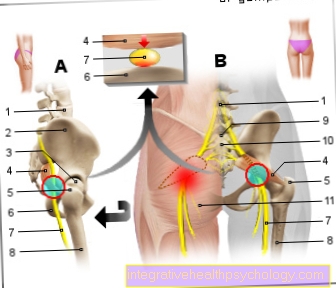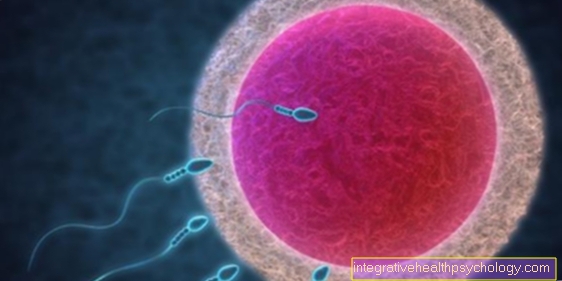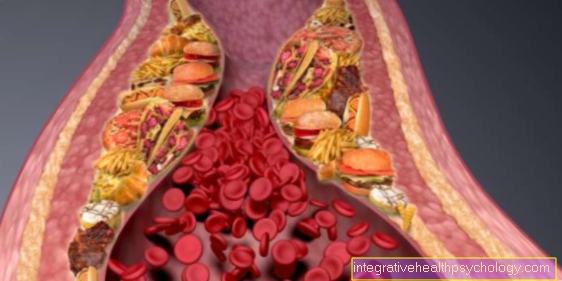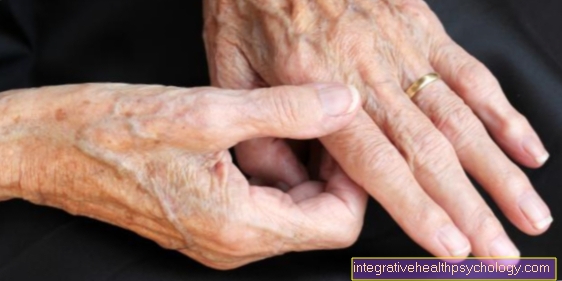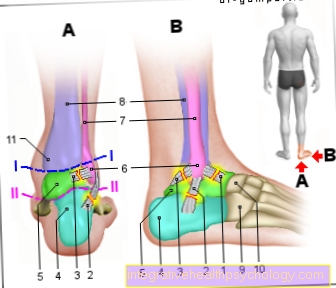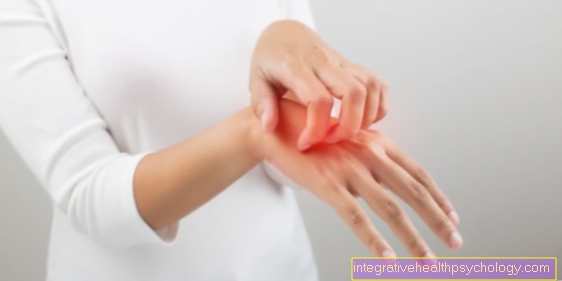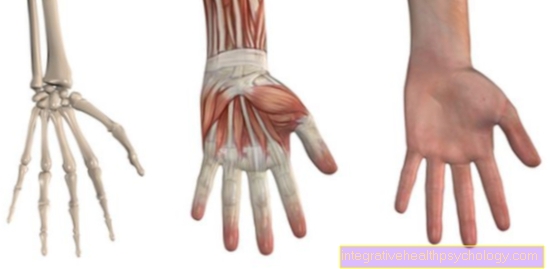Pain during a root canal treatment
introduction
Anyone who is about to undergo root canal treatment knows how severe the pain can be before treatment. But pain can also occur immediately after the root canal treatment, as the tissue is damaged by the fine instruments and irrigation solutions is irritated.
The main pain is eliminated in the first session of the root canal treatment, as the dentist removes all germs and inflamed tissue as possible and thus prevents the inflammatory processes from spreading to the jawbone and the surrounding tissue.

Pain during root canal treatment
In most patients, acute pain in the area of one or more teeth is the reason for a root canal treatment. These pains usually have a dull and then stabbing character.
Most of those affected find the pain particularly uncomfortable when consuming cold or hot food and drinks. Often these even radiate from the ridge to the ears. In the early stages of a root inflammation, in particular, some patients wonder what they can do to bridge the time until the dentist.
The first pain that occurs in connection with a diseased tooth can be alleviated by taking light painkillers.
Since the pain is caused by inflammatory processes inside the tooth, preference should be given to anti-inflammatory preparations.
In particular, the active ingredient ibuprofen has been used successfully in everyday clinical practice to treat this pain. Since the root canal treatment generally has a fixed procedure and local anesthesia is carried out before opening the tooth substance and the root cavity, this can usually be carried out without pain.
If there are strong inflammatory processes in the root canals, it may happen that pain in the area of the tooth to be treated cannot be completely eliminated.
In these cases it is possible to apply the local anesthetic directly into the diseased tooth pulp after opening the root cavity.
In most cases this causes pain, but it subsides after a few seconds.
In some cases, patients report pain that occurs in the first few days after the root canal treatment. This can be an indication that the damaged pulp and / or nerve fibers could not be completely removed. If necessary, the tooth root should be reopened and the root canal treatment improved.
However, pain after a root canal treatment can also be completely harmless and subside on its own after a few days. In most cases, pain after root canal treatment can be treated well with the help of mild pain relievers.
Ibuprofen has a particularly good effect in combating pain in everyday clinical practice after a successful root canal treatment. The active ingredient ibuprofen is able to alleviate the resulting pain and have an inhibitory effect on various inflammatory mediators.
The pain after a root canal treatment can be broken down as follows:
- while chewing
- in the jaw
- after a filling
- during the meal
What can be done about the pain during a root canal treatment?
To prevent pain during a root canal treatment, the dentist will give an injection with a drug (anesthetic) that suppresses the pain. The anesthetic takes between five and ten minutes to work. In some cases, however, the existing inflammation is so severe that it is not possible to completely eliminate the pain.
An attempt can then be made to inject the anesthetic into the root canals in order to numb the nerve directly. In addition, various approaches are currently being worked on, which combine a conventional pain reliever, such as paracetamol, with the syringe. To do this, the tablet is taken a few hours before the start of treatment and then an injection is given at the start of treatment.
In most cases this eliminates the pain. However, if the symptoms get worse during the treatment, you can ask the dentist to give another injection. It also helps to think of something beautiful and to fix a point in the room with your eyes or to rock your leg slightly.
Pain despite numbness
In some cases it is possible that the so-called local anesthesia does not have any or only partial effect. This is due to the existing inflammation of the tooth bed below the tooth, which also triggers the severe pain. An inflammation always causes an increased blood flow rate in the tissue and thus ensures a faster metabolism. As a result, the drug is removed from the tissue more quickly and cannot act on the tooth nerve long enough.
Although the lip and tongue can be numb, the affected tooth will continue to hurt despite the anesthetic. In this case, however, the dentist reacts by injecting another, stronger medication with other additives. In some cases this has the desired effect and alleviates the pain to such an extent that at least the necessary treatment can be carried out.
Pain during laser treatment
In root canal treatment, an attempt is made to remove or destroy all bacteria that have penetrated the root canal. This is achieved on the one hand by removing the infected tissue and on the other hand by using disinfecting rinsing solutions. There is also the option of irradiating the tooth with a laser.
The light can penetrate deep into the tissue and attack the bacterial membrane there. Pain occurs during laser treatment when the light acts on the tissue for too long. The resulting heat can damage the tooth and cause pain.
Read more on the topic: Root canal treatment with laser
Pain-free after the root canal treatment
Most patients are nevertheless absolutely pain-free after this first treatment session of a root canal treatment and only notice a bitter taste in the mouth, which comes from the medication inside the tooth.
As soon as the tooth root is germ-free, it is filled with so-called guttapercha points and a covering filling. Following the root canal treatment, an X-ray control image is used to check whether the root reaches the tip (apex) is filled and the tooth is then closed.
You might also be interested in: Pain after root filling
Drugs for pain after root canal treatment
Pain after a root canal treatment is mostly normal in most cases, as the tooth and the surrounding tissue are exposed to particular stress. Depending on the degree of inflammation, this pain can sometimes last for several days and then necessitate the use of painkillers. In the oral area, ibuprophen and paracetamol in particular have established themselves with their pain-relieving effects.
You should pay particular attention to the maximum daily dose, as tablets are more often used in severe pain. However, some serious side effects then occur. Then it is better to fall back on a lower dose of a stronger drug. For example, Dolomo is useful for very severe pain. This is a mixture of paracetamol, ASA and codeine. Three pain medication that is strong in itself and that, when combined, is even more effective.
However, if the pain does not subside after a few days, a visit to the dentist is inevitable. Because only then can a precise diagnosis and an X-ray be used to decide where the pain is coming from and what can be done about it.
Root canal treatment process
If a patient comes with pain or symptoms that indicate a diseased tooth root, the dentist will tap the teeth, because the irritated tooth nerves then react with a tapping pain. The cause of the complaints should thus be found. In theory it is quite easy to precisely localize the inflamed tooth, but in the practice of root canal treatment the whole thing is a bit more difficult, because the patients usually feel a knock sensitivity in two or even three neighboring teeth.
A so-called vitality test should also be carried out in any case.
During the vitality test, the tooth is exposed to a cold stimulus (using an ice spray and a cotton ball) and checks whether the patient generally feels this cold, whether there is pain or whether the stimulus no longer triggers any reaction. If the tooth is dead, the vitality test will be negative.
At the beginning of the root canal treatment, the treating dentist will usually take a small x-ray of the affected tooth.
Once the root infected tooth has been identified, the actual treatment can begin after anesthesia. During the anesthetic injection, the patient only feels a brief, sharp pain from the penetration of the needle.
A so-called coffer dam is often placed before the start of treatment. This is a stretchable rubber blanket that is attached to the tooth. The cofferdam serves to shield the tooth so that no saliva and bacteria contained in it can get into the tooth. A great advantage is that the canal can then be cleaned well with rinsing solutions without them getting into the oral cavity.
Sometimes only a relative drainage is used. The tooth is only protected from saliva by cotton rolls and the teat.
While this method is more comfortable for the patient, there is a greater risk of saliva and bacteria getting into the tooth root.
Now the tooth is opened with the "drill" during the root canal treatment. The next task of the dentist is to remove the pulp, including the nerve fibers that lie in it, from the tooth root. At this point in the root canal treatment, there is a chance that stabbing pain will occur despite the anesthetic. This is due to the fact that certain substances are formed in the course of the inflammation, which can reduce the effect of local anesthesia.
Read more on the topic: Root canal treatment process
prophylaxis
There is no specific prophylaxis directly on a root canal treatment. Because this treatment only ever takes place after damage to the hard tooth tissue, either through caries or an accident in which the tooth is broken off and the pulp is exposed. That is why oral hygiene, see also dental care, with fluoridated toothpaste and professional teeth cleaning is the best prevention, because they are the best prevention of caries infection.
Pain when chewing
Bite pains after a root canal treatment on the treated tooth are quite possible. The root canal treatment and root filling cause irritation at the root tip and the inflamed tissue. This creates a swelling. The tooth is slightly raised, which means that when the tooth is bite open, it first touches the opposing teeth and is pressed into the still inflamed tissue.
The tooth has a permanent pre-contact due to the minimal protrusion from the bite position of the teeth and is therefore overloaded. This creates bite pain, which only gradually decreases, parallel to the regression of the inflammation below the tip of the root.
The duration of the bite pain should no longer be present after one to two months. If the pain creates persistent pain or gets worse, a Revision, i.e. a repetition of the therapy, to remove any bacteria that may have remained below the tip of the root and to allow the inflammation under the tip of the root to heal completely. The root filling is removed and a new root filling is only inserted when the tooth is symptom-free.
More information can be found here: Toothache when chewing
Pain in the jaw
A few days after a successful root canal treatment, the patient in question should no longer be in pain. In rare cases, pain in the jaw can occur even after an apparently complete root canal treatment.
In the majority of patients, these have a harmless cause (irritation or irritation). Nevertheless, if pain in the jaw has persisted for a long time, despite a root canal treatment that has already been carried out, a dentist should be visited again. This is particularly important, as the inflammatory processes may have migrated from the pulp to the tip of the tooth into the jawbone.
As a result, abscesses or inflammatory bone diseases can develop in the jaw region.
Most jaw pain is like bite pains after an initial root canal treatment, but is normal and not a cause for concern. A root canal treatment is always an irritation to a certain extent, which can cause discomfort after the local anesthesia has subsided.
Keeping the mouth open long and wide for root canal treatment to prevent overuse of the muscles, which can result in jaw pain. This condition is like sore muscles in the masticatory muscles, which are overstretched by keeping the mouth open for a long time. It can also mean that you cannot open your mouth properly for a few days - then you have a jaw clamp.
The complaints of the jaw should, however, have completely receded within one to two weeks and become less and less day by day. If the pain remains the same or even worsens, the dentist must be visited, who will determine the cause and, if necessary, treat it.
You might also be interested in: Temporomandibular joint pain
Apical resection
Even with the most careful root canal treatment, bacteria can still remain in the ramifications of the root canal at its tip.
This can lead to a pus focus at the tip of the root, which is enclosed by the body by a protective wall of connective tissue. However, since it is a latent source of danger, it should be eliminated with a surgical procedure, the root tip resection. For this purpose, the mucous membrane is cut under local anesthesia and the bone over the pus focus is removed. The pus focus is eliminated and with it the tip of the root. Then the root canal is closed with amalgam or cement from the tip so that no more germs can escape. The mucous membrane is sutured again and the resection is complete.
An apicectomy is relatively problem-free for teeth with one root, but very difficult for teeth with multiple roots.
You might also be interested in this topic: Tooth filling with amalgam
Root canal treatment for milk teeth
Treating milk teeth with pulpitis or gangrene is more difficult. Since the milk teeth are smaller and the enamel and dentin are thinner, the pulp is reached faster than with adult teeth. Of course you have to try to preserve the tooth as it serves as a placeholder for the permanent teeth.
On the other hand, it must be taken into account that the permanent tooth is located directly behind the milk tooth and that the roots of the milk tooth are resorbed.Therefore a normal root canal filling or root canal treatment cannot be performed. In any case, the carious tissue is removed, then you have to decide how to proceed. One possibility is to grind the tooth so that there is no jam and no toothache. It remains open or is provided with an antibacterial insert. If the tooth is open, you should make sure that no food particles close it again. With the pulp chamber wide open, this should not cause any problems.
The alternative is to remove the tooth. The important placeholder function has thus been lost. This can be remedied by a placeholder that keeps the gap open so that the permanent tooth can literally break through.
Also read: Caries in children - cause for concern?
Root canal treatment for gangrene
If the pulp is not only inflamed, but also disintegrated due to the action of bacteria, gangrene has developed.
The treatment of gangrene is much more complex and lengthy than that of pulpitis. When the pulp chamber is opened, foul-smelling gases escape, but the patient feels immediate relief because the gases no longer press on the opening at the tip of the root. After removing the disintegrated tooth pulp, the opening is widened and the tooth is initially left open or closed with a cotton ball so that the gases can escape but food residues cannot penetrate. In the next session of the root canal treatment, the root canal will be enlarged and cleaned of residues.
An X-ray shows how far the canal has been worked up. After an antiseptic insert, the tooth is temporarily closed. If the tooth remains without symptoms for a long time, the canal can be filled with gutta-percha or another root filling material and finally closed.
You may also be interested in this topic: Antibiotics after a root canal treatment
Summary
Root canal treatment is used for acutely inflamed pulp. It can be carried out in one session if it is uncomplicated. Treatment for gangrene is more lengthy and complex. The root canal treatment for milk teeth depends on the respective starting position, but differs significantly from that for adults. The root tip resection removes the pus focus at the root tip and the tip itself.
You might also be interested in this topic: Revision of a root canal treatment
Recommendations from our editorial team
- Crown after a root inflammation
- Such is the process of a root canal treatment
- How much does a root canal treatment cost?
- Pain in a tooth root inflammation
- Root canal treatment with laser




